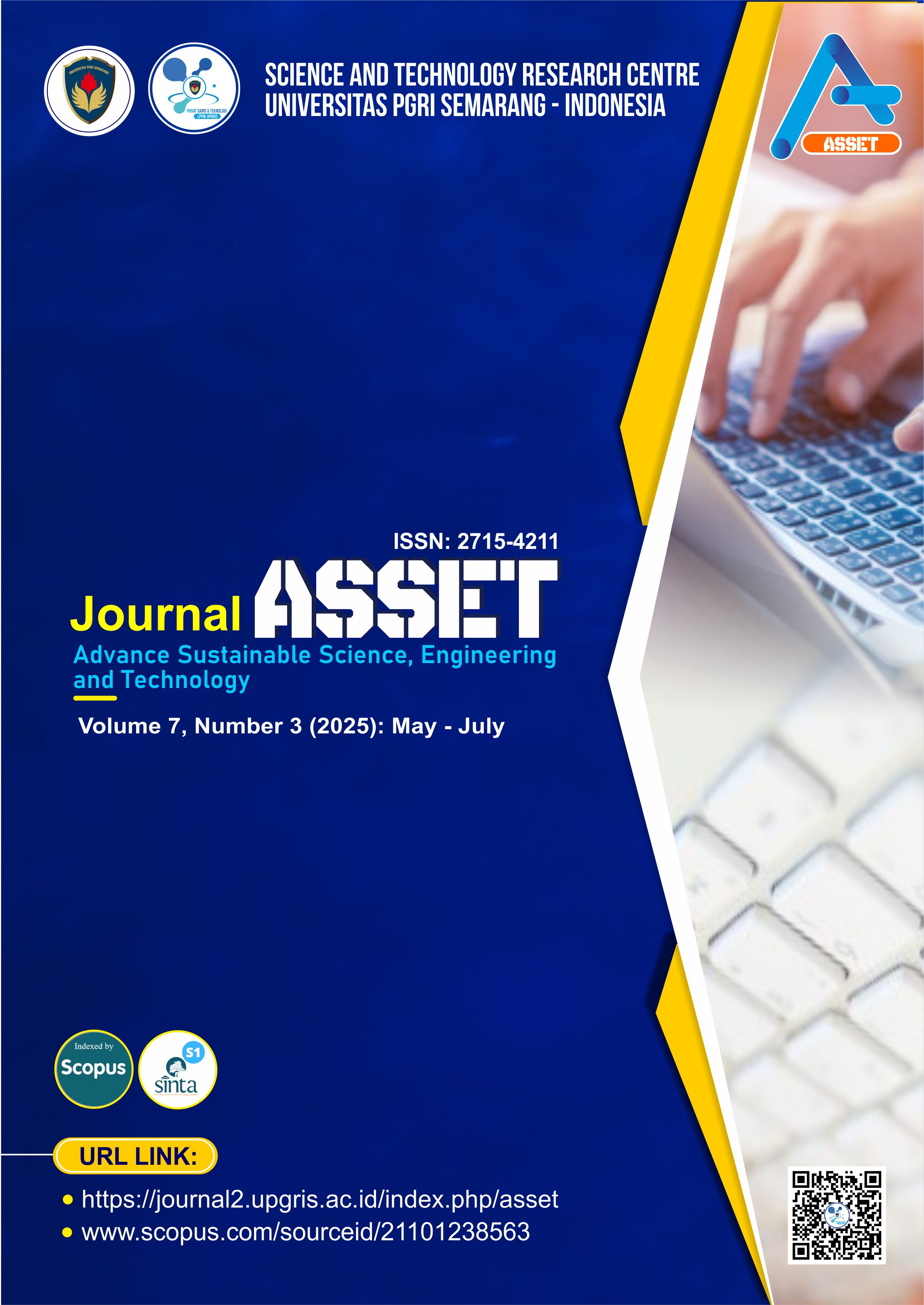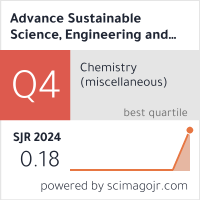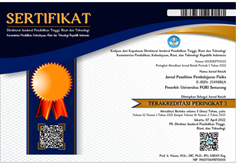Enhanced Air Quality Prediction Using AI: A Comparative Study of GRU, CNN, and XGBoost Models
DOI:
https://doi.org/10.26877/asset.v7i3.1589Keywords:
GRU-based air quality forecasting, deep learning for AQI, spatiotemporal air pollution modeling, PM 2.5 and AQIAbstract
Weather monitoring is vital due to environmental changes and rising air pollution, which affects health and lifestyles. Accurate air quality prediction models are essential yet challenging due to complex weather-pollution interactions. This study employs explainable deep learning and machine learning techniques—GRU, CNN, and XGBoost—on a custom dataset of 100,000 samples with 15 features, including PM2.5, PM10, humidity, and temperature. Using SHAP for interpretability, the GRU model outperforms others with 98.56% accuracy, 98.43% Recall, and 98.52% True Positive Rate. Temperature, humidity, gases, and pressure are key variables influencing predictions. The proposed model achieves high mAP and precision, surpassing existing methods and demonstrating effective real-time forecasting under diverse weather conditions.
References
[1] H. Kan, R. Chen, and S. Tong, ‘‘Ambient air pollution, climate change, and population health in China,’’ Environ. Int., vol. 42, pp. 10–19, Jul. 2012.
[2] H. Zhang, S. Wang, J. Hao, X. Wang, S. Wang, F. Chai, and M. Li, ‘‘Air pollution and control action in Beijing,’’ J. Cleaner Prod., vol. 112, pp. 1519–1527, Jan. 2016.
[3] P. Kumar, L. Morawska, C. Martani, G. Biskos, M. Neophytou, S. Sabatino, M. Bell, L. Norford, and R. Britter, ‘‘The rise of low-cost sensing for managing air pollution in cities,’’ Environ. Int., vol. 75, pp. 199– 205, Feb. 2015.
[4] E. D. Schraufnagel, R. J. Balmes, T. C. Cowl, S. D. Matteis, S.-H. Jung, K. Mortimer, R. Perez-Padilla, B.
[5] M. Rice, H. Riojas-Rodriguez, A. Sood, D. G. Thurston, T. To, A. Vanker, and J. D. Wuebbles, ‘‘Air pollution and noncommunicable diseases a review by the forum of international respiratory societies’ environmental committee, part 2: Air pollution and organ systems,’’ Chest, vol. 155, no. 2, pp. 417–426,
[6] 2019.
[7] Y.-F. Xing, Y.-H. Xu, M.-H. Shi, and Y.-X. Lian,‘‘The impact of PM2.5 on the human respiratory system,’’ J. Thoracic Disease, vol. 8, no. 1, pp. E69– E74, 2016.
[8] J. J. West, A. Cohen, F. Dentener, B. Brunekreef,T. Zhu, B. Armstrong, M. L. Bell, M. Brauer, G. Carmichael, D. L. Costa, and D. W. Dockery, ‘‘What we breathe impacts our health: Improving understanding of the link between air pollution and health,’’ Environ. Sci. Technol., vol. 50, no. 10, pp. 4895–4904, 2016.
[9] X. Zhang, X. Zhang, and X. Chen, ‘‘Happiness in the air: How does a dirty sky affect mental health and subjective well-being?’’ J. Environ. Econ. Manage., vol. 85, pp. 81–94, Sep. 2017.
[10] X. Qi, G. Mei, S. Cuomo, C. Liu, and N. Xu, ‘‘Data analysis and mining of the correlations between meteorological conditions and air quality: A case study in Beijing,’’ Internet Things, vol. 14, Jun. 2021, Art. no. 100127.
[11] S. Al-Janabi, M. Mohammad, and A. Al-Sultan, ‘‘A new method for prediction of air pollution based on intelligent computation,’’ Soft Comput., vol. 24, no. 1, pp. 661–680, Jan. 2020.
[12] Alimissis, K. Philippopoulos, C. G. Tzanis, and D. Deligiorgi, ‘‘Spatial estimation of urban air pollution with the use of artificial neural network models,’’ Atmos. Environ., vol. 191, pp. 205–213, Oct. 2018.
[13] H. Li, J. Wang, R. Li and H. Lu, "Novel analysis- forecast system based on multi-objective optimization for air quality index", J. Cleaner Prod., vol. 208, pp. 1365-1383, Jan. 2019. Show in Context CrossRef Google Scholar Kumar and P. Goyal, "Forecasting of daily air quality index in Delhi", Sci. Total Environ., vol. 409, no. 24, pp. 5517-5523, Nov. 2011.
[14] W. G. Cobourn, "An enhanced PM2.5 air quality forecast model based on nonlinear regression and back-trajectory concentrations", Atmos. Environ., vol. 44, no. 25, pp. 3015-3023, Aug. 2010.
[15] T. S. Rajput and N. Sharma, "Multivariate regression analysis of air quality index for Hyderabad city: Forecasting model with hourly frequency", Int. J. Appl. Res., vol. 3, no. 8, pp. 443-447, 2017.
[16] Y. Liu, Q. Zhu, D. Yao and W. Xu, "Forecasting urban air quality via a back-propagation neural network and a selection sample rule", Atmosphere, vol. 6, no. 7, pp. 891-907, Jul. 2015.
[17] S. Xiao, Q. Y. Wang, J. J. Cao, R.-J. Huang, W.D. Chen, Y. M. Han, et al., "Long-term trends in visibility and impacts of aerosol composition on visibility impairment in Baoji China", Atmos. Res., vol. 149, pp. 88-95, Nov. 2014.
[18] Y. Qi, Q. Li, H. Karimian and D. Liu, "A hybrid model for spatiotemporal forecasting of PM2.5 based on graph convolutional neural network and long short- term memory", Sci. Total Environ., vol. 664, pp. 1-10, May 2019.
[19] C. Wen, S. Liu, X. Yao, L. Peng, X. Li, Y. Hu, et al., "A novel spatiotemporal convolutional long short- term neural network for air pollution prediction", Sci. Total Environ., vol. 654, pp. 1091-1099, Mar. 2019.
[20] J. Schmidhuber, "Deep learning in neural networks: An overview", Neural Netw., vol. 61, pp. 85-117, Jan. 2015.
[21] Z. Ma and G. Mei, "Deep learning for geological hazards analysis: Data models applications and opportunities", Earth-Sci. Rev., vol. 223, Dec. 2021.
[22] S. Du, T. Li, Y. Yang and S.-J. Horng, "Deep air quality forecasting using hybrid deep learning framework", IEEE Trans. Knowl. Data Eng., vol. 33, no. 6, pp. 2412-2424, Jun. 2021.
[23] Y. Zhou, F.-J. Chang, L.-C. Chang, I.-F. Kao and Y.-S. Wang, "Explore a deep learning multi-output neural network for regional multi-step-ahead air quality forecasts", J. Clean Prod., vol. 209, pp. 134- 145, Feb. 2019.
[24] Y. Jiao, Z. Wang and Y. Zhang, "Prediction of air quality index based on LSTM", Proc. IEEE 8th Joint Int. Inf. Technol. Artif. Intell. Conf. (ITAIC), pp. 17-20, May 2019.
[25] R. J. Kuo, B. Prasetyo and B. S. Wibowo, "Deep learning-based approach for air quality forecasting by using recurrent neural network with Gaussian process in Taiwan", Proc. IEEE 6th Int. Conf. Ind. Eng. Appl. (ICIEA), pp. 471-474, Apr. 2019.
[26] Y.-S. Chang, H.-T. Chiao, S. Abimannan, Y.-P. Huang, Y.-T. Tsai and K.-M. Lin, "An LSTM-based aggregated model for air pollution forecasting", Atmos. Pollut. Res., vol. 11, no. 8, pp. 1451-1463,Aug. 2020.
[27] https://github.com/openaq
[28] Vishnu, T. R., Kumar, K. S., Ahammad, S. K. H., Kumar, G. N. S., Umakanth, N., Rao, M. C., & Krishna, S. (2023). Atmospheric Science Variations of pre-monsoon season related atmospheric parameters over Kakinada region. Journal of the National Science Foundation of Sri Lanka, 555.
[29] Kailasam, S., Achanta, S. D. M., Rama Koteswara Rao, P., Vatambeti, R., & Kayam, S. (2022). An IoT-based agriculture maintenance using pervasive computing with machine learning technique. International Journal of Intelligent Computing and Cybernetics, 15(2), 184-197.
[30] Ahmed, A. A. M., Jui, S. J. J., Sharma, E., Ahmed, M. H., Raj, N., & Bose, A. (2024). An advanced deep learning predictive model for air quality index forecasting with remote satellite-derived hydro-climatological variables. Science of The Total Environment, 906, 167234.
[31] Mohammadshirazi, A., Nadafian, A., Monsefi, A. K., Rafiei, M. H., & Ramnath, R. (2023). Novel Physics-Based Machine-Learning Models for Indoor Air Quality Approximations. arXiv preprint arXiv:2308.01438.
[32] Ayoub, A., Wainwright, H. M., & Sansavini, G. (2024). Machine learning-enabled weather forecasting for real-time radioactive transport and contamination prediction. Progress in Nuclear Energy, 173, 105255.
[33] Gong, Y., Zhang, Y., Wang, F., & Lee, C. H. (2024). Deep learning for weather forecasting: A cnn-lstm hybrid model for predicting historical temperature data. arXiv preprint arXiv:2410.14963.
[34] Ben Bouallègue, Z., Clare, M. C., Magnusson, L., Gascón, E., Maier-Gerber, M., Janoušek, M., ... & Pappenberger, F. (2024). The rise of data-driven weather forecasting: A first statistical assessment of machine learning–based weather forecasts in an operational-like context. Bulletin of the American Meteorological Society, 105(6), E864-E883.
[35] Akilan, T., & Baalamurugan, K. M. (2024). Automated weather forecasting and field monitoring using GRU-CNN model along with IoT to support precision agriculture. Expert systems with applications, 249, 123468.
[36] Sun, Y., Deng, K., Ren, K., Liu, J., Deng, C., & Jin, Y. (2024). Deep learning in statistical downscaling for deriving high spatial resolution gridded meteorological data: A systematic review. ISPRS Journal of Photogrammetry and Remote Sensing, 208, 14-38.











